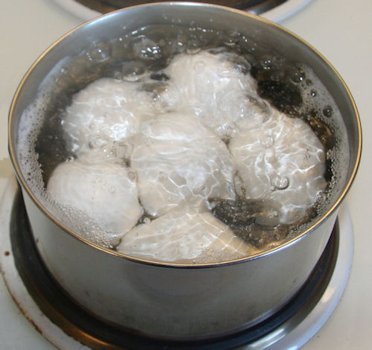
|
Boiling Points of Water
From the book “Kitchen Science” by Howard Hillman
Salt:
Salt, sugar, and practically any other substance will elevate the boiling
point and therefore shortens cooking time. The difference in temperature
between unsalted and salted water (one teaspoon of salt per quart of water) is
about 1° to 2° F, a difference that can be critical in cooking situations
demanding exactness.
Hard Water:
Hard water defines water with a high level of dissolved mineral
salts. Therefore, hard water boils at a higher temperature. The difference in
the boiling point between typical supplies of hard and soft water is about a
degree or two.
Alcohol:
Alcohol has a lower boiling point that water (about 175° F as compared
with 212° F). If you dilute water with alcohol, the mixture will have a lower
boiling point up until the alcohol completely evaporates. Should you decide to
alter an existing recipe by substituting a fair portion of wine for some of the
water, remember to extend the cooking time by 5 to 10 percent depending on the
alcohol strength of the wine and the heaviness of your touch.
Weather:
The boiling point of water is a degree or two lower on stormy, as
opposed to fair, weather days. Consequently, boiled food will take longer to
cook on a stormy day.
Different Size Pans:
Will a given volume of water boil at a higher temperature
in a tall, narrow pot than in a short, wide one? Yes. since the tall, narrow
pot has a great depth, its bottom-lying water is under greater pressure from
the water above it than is the water at the bottom of the short, wide pot. The
greater the pressure, the higher the boiling point will be. The difference is
approximately 1° F.
|
|
Altitude:
The higher the altitude, the lower the atmospheric pressure. The less
atmospheric pressure that bears down on the surface of the liquid, the easier
it is for water molecules to escape into the air. Thus, the water comes to its
full rapid boil at a lower temperature in the mile-high city of Denver than it
can in coastal Miami. For each thousand feet above sea level, the boiling point
of water drops almost 2° F.
Return to Step 3
|
